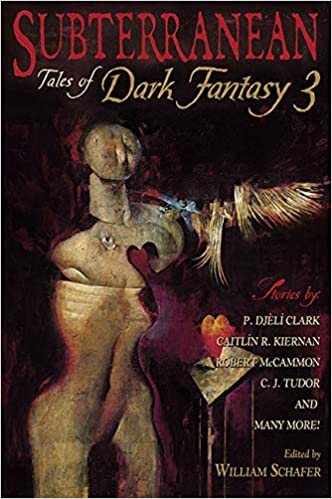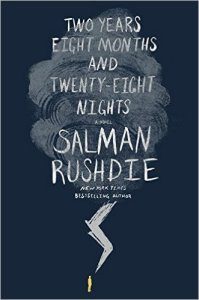Paula Guran Reviews Subterranean: Tales of Dark Fantasy 3 , Edited by William Schafer
 Subterranean: Tales of Dark Fantasy 3, William Schafer, ed. (Subterranean 978-1-59606- 966-4, $40.00, 240pp, hc) July 2020.
Subterranean: Tales of Dark Fantasy 3, William Schafer, ed. (Subterranean 978-1-59606- 966-4, $40.00, 240pp, hc) July 2020.
The third of an occasional anthology series (previous volumes appeared in 2008 and 2011), William Schafer’s Subterranean: Tales of Dark Fantasy 3 offers ten stories by top-notch writers. It starts off with ”An Orderly Progression of Hearts” by Kat Howard, a very short rumination on the vagaries of the human heart. Next up is Caitlín R. Kiernan’s ”Cherry Street Tango, Sweatbox Waltz”, a near-future neo-noir story featuring Elenore Sakellarios, an accomplished assassin undergoing torture that includes Lewis Carroll and fairytale responses. It is fascinating, but reads somewhat like an excerpt from a longer work that might prove even more fulfilling reading.
”Estate Sale” by Bentley Little is a well-written Twilight Zone-type tale about a woman who discovers a neighborhood estate sale is selling items identical to her own.
Stephen Gallagher’s ”Twisted Hazel” is a memorable ghost story concerning a haunted house that is being stripped of its contents and is destined for destruction. It’s a lovely story that is more touching than chilling.
Robert McCammon’s ”Death Comes for the Rich Man” is a reprint (it first appeared in the limited 2012 edition of The Providence rider). Set in 1702 colonial America, it features ”problem solver” Matthew Corbett. (McCammon has written a number of historical thrillers featuring the character.) As the story of an attempt to cheat Death, both the effort at a period setting and the story itself fell a bit flat to me.
”At the Threshold of Your Bedchamber for the Fifth Night” by Sarah Gailey is a nicely done, dark fairy tale. Any suitor who can manage to stay awake in Princess Amalia’s bedchamber for five nights will win her hand and a kingdom. Twenty men have failed. The twenty-first wooer is the resilient young woman who tells the tale.
The world as we know it is beginning to fall apart in C.J. Tudor’s ”Final Course”. Tom is not thrilled with the idea of a reunion with his college pals, but welcomes the chance to get his young daughter, Millie, out of increasingly dangerous London to his old friend Harry’s country house. Once there, not everyone is pleased that the blind child is part of the party. The blind, it is rumored, have a connection to the darkness now dominating the Earth. Of course people always finds scapegoats in time of trouble. The situation at the estate is not exactly as they expected, either. It seems Harry has an idea about using it to ”commercialize the apocalypse.” Distasteful, yes, but perhaps the scheme would provide shelter from the societal storm that is already raging and sure to worsen. Things, however, don’t turn out as anyone expects. Tudor masterfully sets it all up for maximum impact and wickedly plays our own expectations against us.
Richard Kadrey’s ”Razor Pig” also plays with reader expectation, but not by saving the unexpected for a finale. One can’t help but sympathize with David O’Meara, an ex-cop and current security guard, whose daughter Lucy has disappeared. Armed with a gun and a clue that she has joined up with a strange carnival, he goes out to search for her, but we aren’t too far into his quest when we learn that O’Meara is not just a benign-but-distressed-man. This is a tale of the dark and the even darker.
The longest tale in the book, novelette ”Skin Magic” (a reprint from the 2011 anthology Griots) offers depth enough to rival a novel. P. Djèlí Clark’s alternate world resembles West Africa’s medieval kingdoms, but has shaggy beasts with blue horns and giant lizards to provide transport over the shifting sands of the desert. Makami, once a clever thief, is cursed. He is barely surviving in the back streets of a small town far from his home. When he is set upon by men who have nothing good in mind for him, we discover his curse may be terrible, but it can also brutally defend him. He is befriended by a wealthy trader, Master Dawan, who feeds and clothes Makami in exchange for his labor. The trader also has seven lovely daughters, the eldest of whom, Kahya, is not only better at barter than her father, but intelligently runs the whole trading enterprise. Kahya also secretly possesses a form of ”skin magic” and teaches Makami how to partially control the sorcery that curses him. But there are dark folk seeking Makami and, unknowingly, his presence among Dawan’s family threatens their existence even more than the treacherous sand storms. Highly enjoyable: endearing characters, adventure, magic, and even a hint of romance. This one could be expanded into an adventurous epic fantasy.
Paula Guran has edited more than 40 science fiction, fantasy, and horror anthologies and more than 50 novels and collections featuring the same. She’s reviewed and written articles for dozens of publications. She lives in Akron, Ohio, near enough to her grandchildren to frequently be indulgent.
This review and more like it in the June 2020 issue of Locus.
 While you are here, please take a moment to support Locus with a one-time or recurring donation. We rely on reader donations to keep the magazine and site going, and would like to keep the site paywall free, but WE NEED YOUR FINANCIAL SUPPORT to continue quality coverage of the science fiction and fantasy field.
While you are here, please take a moment to support Locus with a one-time or recurring donation. We rely on reader donations to keep the magazine and site going, and would like to keep the site paywall free, but WE NEED YOUR FINANCIAL SUPPORT to continue quality coverage of the science fiction and fantasy field.







